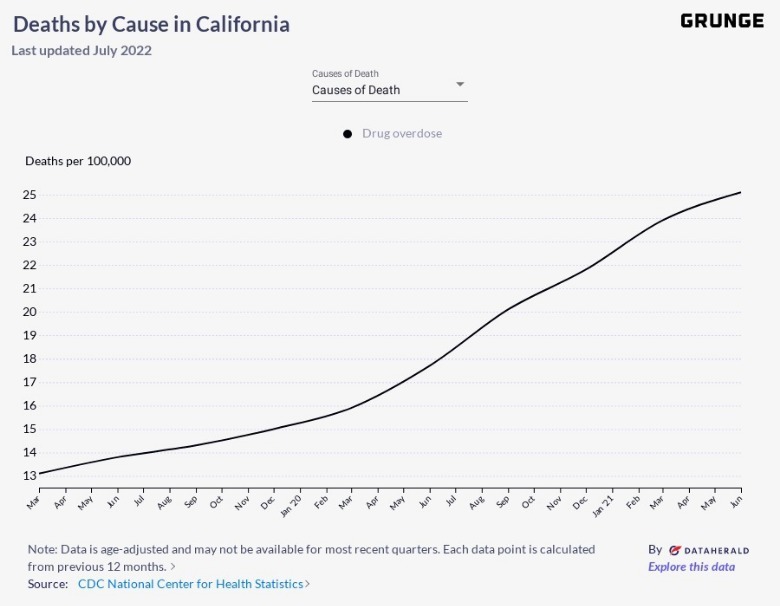The Stats On Drug Overdose Deaths In California Are Worse Than You Realize
The following story contains data related to drug overdoses.
Drug overdose deaths are rising all across the U.S., according to 2022 reporting from The New York Times. Overall, overdose deaths in the U.S. are four times higher than in 1999, based on data from the Centers for Disease Control and Prevention (CDC). Contributing to the issue, synthetic opioids such as fentanyl and other types of methamphetamine are more common than ever, as The Times notes. In 2020 alone, some 90,000 Americans died from an overdose or a 30% increase from the previous year. From there, drug-related fatality shot up an additional 15% in 2021 to reach an all-time high, with Black and Native American populations especially hard hit by the issue, according to NPR.
One state where drug overdose statistics are particularly alarming is California. In the state, more than 10,000 people died from a drug-related overdose from fall 2020 through 2021, an astounding 70% increase over 2019, according to the California Department of Health Care Services (DHCS). Like elsewhere in the U.S., fentanyl and other synthetic opioids contributed most to those drug-related fatalities, as the California DHCS reports. Based on the graph below, the drug overdose crisis in California per 100,000 residents is plain to see. What's more, those numbers have steadily increased since 2019. While simple solutions are hard to come by, California state leaders have taken important steps to help address the issue.
The California overdose problem worsened during the COVID-19 pandemic
As seen in the graph above, drug overdose rates in the state of California per 100,000 residents have increased from roughly 13 deaths per month in March 2019 to around 25 deaths per month in summer 2022. That said, according to data from the CDC, California ranks somewhere in the middle in terms of overdose rates per capita, with states like West Virginia atop that list. Disruptions caused by the COVID-19 pandemic help explain that increase, with higher than expected numbers of overdose deaths across all racial and ethnic groups in that same time period. California's Black population, though, has been most affected, as the National Center for Biotechnology Information notes. According to 2021 data from Pew Research, California has the fifth largest Black population in the country.
What's also notable about the California epidemic of death caused by overdose is that more than half of all such fatalities resulted from fentanyl use, for a 300% increase since 2019. That number was followed by a roughly 90% increase in psycho-stimulant overdose, and around a 50% increase in cocaine-related overdose mortality, according to the California DHCS. Addressing the drug overdose crisis in California will prove difficult, as it has elsewhere in the U.S. Steps that state leaders have taken so far include policy changes, improved healthcare access, and increased education among state residents and healthcare providers, according to the California Department of Public Health. One area of focus in particular is the California Medication Assisted Treatment (MAT) Expansion Project, as the California DHCS notes.
If you or anyone you know needs help with addiction issues, help is available. Visit the Substance Abuse and Mental Health Services Administration website or contact SAMHSA's National Helpline at 1-800-662-HELP (4357).

